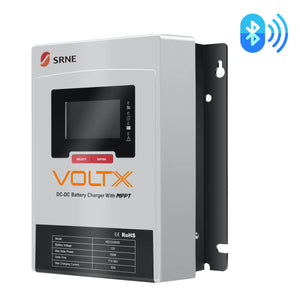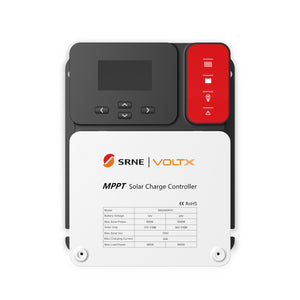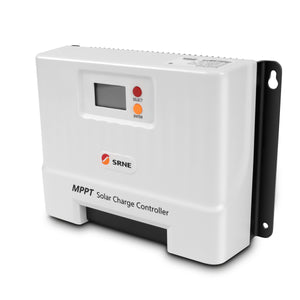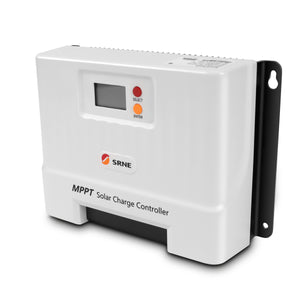VoltX SRNE 12V 30A DC-DC MPPT LiFePO4 Battery Charger with Bluetooth
$319.99Unit price /UnavailableVoltX SRNE 12V 50A DC-DC MPPT LiFePO4 Battery Charger with Bluetooth
$359.99Unit price /Unavailable
Lithium Battery Chargers
Given the rise of advanced lithium battery technology, understanding the nuances of different chargers is crucial. Whether you're gearing up for an outback adventure, ensuring your boat is ready for the water, or simply seeking reliable power for your caravan, the right charger makes all the difference. This guide will help you navigate the options, from LiFePO4 battery chargers to sophisticated DC to DC chargers, ensuring you make an informed decision that suits your specific power requirements.
Understanding the Main Types of Battery Chargers Available
Not all battery chargers are created equal. The type of battery you have, your power source, and your specific application will dictate the best choice. Let's explore the most common and effective types on the market, ensuring you find a match for your deep cycle battery charger needs or portable power requirements. Each charger type serves distinct purposes, from maintaining batteries during storage to providing reliable power whilst off-grid, making it essential to understand their unique characteristics and applications.
LiFePO4 Battery Chargers: Powering Your Lithium Batteries
Lithium Iron Phosphate (LiFePO4) batteries are increasingly popular for their longevity and safety, but they require specific charging profiles that generic chargers simply cannot provide. A dedicated LiFePO4 battery charger ensures optimal performance and extends battery life by communicating effectively with the battery's management system. These specialised chargers deliver precise voltage and current stages, including bulk, absorption, and float phases, tailored specifically for lithium iron phosphate batteries.
For those searching "LiFePO4 battery charger Australia," it's crucial to select models that comply with local electrical standards and can handle the harsh Australian climate conditions. Unlike conventional chargers, a proper LiFePO4 charger prevents overcharging, undercharging, and thermal runaway, whilst maximising the battery's cycle life and maintaining its capacity over thousands of charge cycles.
DC to DC Chargers: Your On-The-Go Power Solution
For those who need to charge batteries while on the move, such as in a 4WD, caravan, or boat, a DC to DC charger is absolutely essential for maintaining auxiliary battery systems. These sophisticated units efficiently capture power from your vehicle's alternator or solar panels to charge your auxiliary battery, often a 12V lithium battery, using advanced boost and buck-boost technology.
A DC to DC lithium battery charger is vastly superior to older Voltage Sensitive Relay (VSR) systems, particularly with modern smart alternators that reduce output when they detect additional electrical loads. These chargers provide multi-stage charging profiles that ensure your auxiliary batteries receive the correct voltage and current, regardless of the input source voltage fluctuations. They're particularly valuable for long-distance touring, camping, and marine applications where reliable auxiliary power is critical for running appliances, lighting, and communication equipment.
MPPT Solar Charge Controllers: Maximising Your Sun Power
If you're harnessing solar energy, an MPPT solar charge controller is absolutely key to extracting maximum efficiency from your photovoltaic panels, especially in Australia's variable weather conditions. Maximum Power Point Tracking (MPPT) technology continuously optimises power harvest by adjusting the electrical operating point of the panels, typically achieving 20-30% better performance than older PWM controllers.
This advanced solar charge controller technology is particularly beneficial during partial shading, low light conditions, and temperature variations common in the Australian climate. An MPPT controller intelligently converts excess panel voltage into additional current, ensuring your battery bank receives optimal charging even when conditions aren't perfect. When integrated with a 12V battery charger system, these controllers provide seamless power management that maximises solar investment returns whilst extending battery life through precise charge control.
Versatile AC Battery Chargers: For Home and Workshop Use
An AC battery charger serves as the backbone for maintaining batteries from mains power (240V in Australia), making them ideal for pre-trip preparation, workshop applications, and long-term battery storage. These versatile units range from basic trickle chargers that provide gentle maintenance charging to sophisticated smart battery charger systems capable of handling multiple chemistry types including AGM, gel, and lithium batteries.
Modern 240V lithium battery charger models incorporate microprocessor control, temperature compensation, and multiple safety protections to ensure safe, efficient charging regardless of battery type. They're particularly valuable for maintaining seasonal equipment batteries, charging batteries before extended trips, and providing reliable workshop power solutions. Advanced models feature selectable chemistry settings, allowing one charger to service various battery types safely and effectively.
Choosing the Right Battery Charger: Key Considerations
Selecting the ideal battery chargers involves more than simply picking a type from the shelf. You need to carefully consider battery chemistry compatibility, voltage requirements, amperage specifications, and advanced features that align with your specific power needs. Whether you require a robust 12V battery charger for a camper trailer or a sophisticated multi-output unit for your yacht, understanding these critical factors ensures optimal performance, safety, and longevity. The investment in quality charging equipment pays dividends through extended battery life, improved reliability, and enhanced safety during operation.
Battery Chemistry Compatibility: SLA, LiFePO4 and More
The most critical factor in charger selection is ensuring perfect compatibility between the charger and your battery's chemistry, as mismatched charging profiles can result in reduced performance, shortened lifespan, or even dangerous battery failure. A charger designed for Sealed Lead Acid (SLA) batteries will not properly charge lithium batteries and may cause permanent damage to expensive LiFePO4 cells.
When searching for the best battery charger for lithium batteries, it's essential to verify that the unit specifically supports your battery chemistry with appropriate voltage stages, current limits, and temperature compensation. Multi-chemistry chargers, such as LiFePO4 chargers, offer versatility by automatically detecting battery type or allowing manual selection, but they typically cost more than dedicated single-chemistry units. Understanding the distinct charging requirements for AGM, gel, flooded lead-acid, and various lithium chemistries ensures you select a charger that optimises performance whilst maintaining safety standards.
Voltage and Amperage: Getting the Power Right
Understanding voltage and amperage specifications is vital for safe, efficient battery charging, as incorrect specifications can result in inadequate charging, extended charge times, or potential equipment damage. The charger's voltage output must precisely match your battery system voltage - a 12V battery charger for 12-volt systems, 24V units for 24-volt configurations - with no room for compromise in this critical specification.
Amperage selection affects charging speed significantly; higher amperage chargers complete charging cycles faster, but must remain within the battery manufacturer's maximum charge current specifications. For lithium battery charger 12V applications, manufacturers often allow charging rates from 20% up to 100% of the battery's amp-hour capacity, whilst lead-acid batteries typically require more conservative rates of 10-20% of capacity. Properly sized charging current ensures optimal battery life, prevents overheating, and maintains safety throughout the charging process.
Smart Features: Bluetooth Monitoring and Advanced Protection
Modern battery chargers incorporate sophisticated smart battery charger technology that transforms basic charging into comprehensive battery management systems with real-time monitoring and protection capabilities. Multi-stage charging algorithms automatically progress through bulk, absorption, and float phases, optimising charge acceptance whilst preventing overcharging and stratification issues common with simpler chargers. Advanced safety protections including short circuit protection, reverse polarity protection, over-temperature shutdown, and spark-proof connections ensure safe operation even in demanding environments.
Bluetooth battery charger functionality enables remote monitoring via smartphone applications, allowing users to track charging progress, battery health, and system status from convenient distances. Temperature compensation automatically adjusts charging parameters based on ambient conditions, crucial for Australia's extreme temperature variations, ensuring optimal charging performance regardless of seasonal conditions.
Application Specifics: Chargers for Camping, Caravans and Marine Use
Your intended application significantly influences charger selection, as different environments and usage patterns demand specific features, mounting options, and environmental protection ratings. Camping enthusiasts often prioritise portable solar charge controller systems or compact DC to DC charger units that integrate seamlessly with vehicle electrical systems for reliable off-grid power generation. Caravan and recreational vehicle owners typically require higher capacity charging systems capable of maintaining substantial battery banks for extended off-grid periods, often featuring multiple output options for diverse battery chemistries.
Marine environments present unique challenges requiring chargers with ignition protection ratings, corrosion-resistant housings, and the ability to charge multiple battery banks simultaneously whilst withstanding constant vibration and moisture exposure. Each application demands careful consideration of mounting requirements, environmental protection, connectivity options, and integration with existing electrical systems to ensure reliable, long-term performance.
Optimising Performance and Lifespan of Your Batteries and Chargers
Investing in quality battery chargers represents only the initial step towards reliable power management; proper installation, operation, and maintenance practices ensure maximum return on investment through extended equipment life and optimal performance. Understanding correct charging procedures, recognising warning signs, and implementing preventive maintenance schedules protects both your expensive batteries and charging equipment from premature failure. Following manufacturer guidelines and industry best practices for your lithium battery charger or other charger types ensures safe operation whilst maximising the significant investment in modern power systems.
Best Practices for Charging Your Batteries Safely
Safety must remain the paramount consideration when operating any battery charger, as improper procedures can result in equipment damage, personal injury, or fire hazards that proper protocols easily prevent. Always ensure adequate ventilation around charging areas, particularly when charging lead-acid batteries that emit potentially dangerous gases during the charging process. Correct connection procedures - connecting positive terminals first, then negative, and reversing the sequence during disconnection - prevent dangerous sparks and potential short circuits.
Understanding your battery charger's indicator lights, display messages, and alarm signals enables prompt response to abnormal conditions before they escalate into serious problems. For 12V LiFePO4 battery charger applications, verify that the Battery Management System (BMS) is functioning correctly and that all connections are secure before initiating charging cycles, as lithium batteries require precise monitoring throughout the charging process.
Maintaining Your Charger for Long-Term Reliability
While modern battery chargers are designed for minimal maintenance, implementing simple preventive care procedures significantly extends operational life and maintains peak performance throughout years of service. Regular cleaning of ventilation areas, connection points, and external surfaces prevents dust accumulation and corrosion that can impair performance and create safety hazards over time. Periodic inspection of charging cables, connectors, and mounting hardware identifies wear patterns and potential failure points before they result in system downtime or safety concerns. For complex installations such as DC to DC charger systems, ensuring secure mounting, proper wire routing, and adequate airflow around the unit prevents vibration damage and overheating issues common in mobile applications. Smart chargers with updateable firmware benefit from periodic software updates that improve performance, add features, and address any operational issues identified through ongoing development.
Key Takeaways for Your Battery Charger Purchase
Choosing the right battery chargers forms a critical component of any reliable power system, whether for recreational, marine, or professional applications requiring dependable electrical power. By understanding the fundamental differences between LiFePO4 battery chargers, DC to DC chargers, MPPT solar charge controllers, and traditional AC chargers, you're well-equipped to make informed decisions that match your specific requirements. Consider the crucial factors of battery chemistry compatibility, voltage and amperage specifications, smart features, and application-specific needs when evaluating potential purchases. Remember that matching the charger precisely to your battery type and intended use ensures optimal performance, safety, and longevity. Prioritise quality construction, comprehensive safety features, and reliable manufacturer support for long-term satisfaction, particularly for critical applications requiring dependable off-grid power in Australia's demanding conditions.
Frequently Asked Questions
- What type of charger do I need for a LiFePO4 battery?
You need a specific LiFePO4 battery charger or a multi-chemistry charger with a LiFePO4 setting. These chargers have the correct charging profile with appropriate voltage and current stages to safely and fully charge LiFePO4 batteries whilst working harmoniously with their Battery Management System (BMS). Using an incorrect charger can damage expensive lithium batteries or fail to charge them properly.
- Can I use a car battery charger on a lithium battery?
Generally, no. Standard car battery chargers are designed specifically for lead-acid batteries and can damage lithium batteries or fail to charge them correctly due to incompatible voltage profiles and charging algorithms. Always use a charger specifically designed for lithium battery charger chemistry to ensure safe, effective charging and protect your investment.
- What is a DC to DC charger and why do I need one?
A DC to DC charger is essential for charging auxiliary batteries from a vehicle's alternator or solar panels whilst on the move. It's particularly crucial for modern vehicles with smart alternators and provides controlled, multi-stage charging that improves battery life and performance. A DC to DC lithium battery charger is especially important for maintaining LiFePO4 auxiliary batteries in touring and camping applications.
- How does an MPPT solar charge controller work?
An MPPT solar charge controller uses Maximum Power Point Tracking technology to intelligently adjust its input parameters, harvesting maximum possible power from solar panels by continuously optimising the electrical operating point. It converts excess panel voltage into additional charging current, making it significantly more efficient than PWM controllers, particularly in variable light conditions common in Australian climates.
- What size battery charger do I need in terms of amperage?
For LiFePO4 batteries, charger amperage can typically range from 20% up to 100% of the battery's amp-hour capacity, depending on manufacturer specifications. For lead-acid batteries, a general guideline suggests 10-20% of the battery's Ah rating. For example, a 100Ah battery would typically use a 10-20A battery charger for lead-acid chemistry, though always consult manufacturer recommendations for optimal charging rates.
- What is a smart battery charger?
A smart battery charger utilises microprocessor technology to monitor battery condition continuously and automatically adjust the charging process through multiple stages including bulk, absorption, and float phases. This intelligent approach ensures optimal charging, prevents overcharging, extends battery life, and provides comprehensive safety protection throughout the charging cycle.
- How long does it take to charge a deep cycle battery?
Charging time depends on the battery's capacity (Ah), depth of discharge, and charger amperage. For example, a 100Ah battery discharged by 50% would require approximately 5 hours with a 10A deep cycle battery charger, plus additional time for the absorption phase. Higher amperage chargers reduce charging time proportionally, provided they remain within manufacturer specifications.
- Is it safe to leave a battery charger connected all the time?
Modern smart battery chargers with maintenance or float modes are designed for continuous connection, automatically maintaining optimal battery charge without overcharging. However, always verify manufacturer recommendations for your specific battery chargers and battery type, as requirements may vary between different technologies and applications.
- What's the difference between a 12V battery charger and a 24V charger?
The voltage rating indicates the battery system voltage they're designed to service. A 12V battery charger is for 12-volt batteries and systems (common in cars, caravans, boats), whilst 24V chargers service 24-volt systems (found in larger trucks, commercial vessels). Using incorrect voltage chargers can cause serious damage to batteries and electrical systems.
- Can I charge different types of lithium batteries with the same lithium charger?
LiFePO4 is the most common lithium chemistry in recreational applications, but other types exist including Li-ion and LiPo, each with different charging requirements. Most consumer "lithium battery chargers" are designed specifically for LiFePO4 chemistry. Always verify that your charger explicitly states compatibility with your specific lithium chemistry, as using incorrect charging profiles can damage expensive lithium batteries.
- What does 'trickle charger' mean?
A trickle charger delivers very low, continuous current to maintain battery charge and prevent self-discharge during extended storage periods. This gentle charging approach prevents battery deterioration during seasonal storage and keeps batteries ready for immediate use. Many modern smart battery chargers include automatic trickle or maintenance modes that activate after completing full charging cycles.
- Where can I find the best battery charger for lithium batteries?
Here at Outbax, we offer high-quality LiFePO4 battery chargers designed for Australian conditions, with features like temperature compensation and full compliance with local electrical standards. All our chargers come with clear specs, local support, and solid warranties—so you can charge up with confidence.
Frequently Asked Questions
- What type of charger do I need for a LiFePO4 battery?
- Can I use a car battery charger on a lithium battery?
- What does 'trickle charger' mean?
- Where can I find the best battery charger for lithium batteries?
- What is a DC to DC charger and why do I need one?
- How does an MPPT solar charge controller work?
- What size battery charger do I need in terms of amperage?
- What is a smart battery charger?
- How long does it take to charge a deep cycle battery?
- Is it safe to leave a battery charger connected all the time?
- What's the difference between a 12V battery charger and a 24V charger?
- Can I charge different types of lithium batteries with the same lithium charger?









